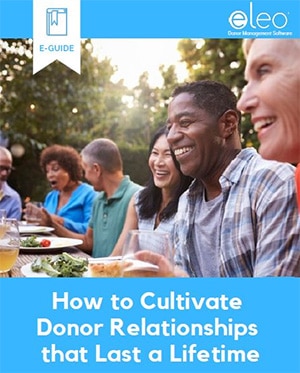
You’ve laid the groundwork – your major gift threshold is set, current major givers have been identified, and potential prospects have been located. So, what’s next? To finish out our 3-part blog series on ‘Developing a Major Gifts Program’ at your small nonprofit, we will shift our focus to – the art of the ask and fundraising follow up. In other words, it’s time to dive into your Major Gifts Program communications strategy.
For a Major Gifts Program, communication is not a one and done. Communicating with high level donors will need to be regular and prompt. Sound impossible as a small nonprofit? Good news – your major gifts program should represent only about 5% of your donors, so it’s usually just a handful of people you need to keep top of mind.
Now, let’s talk about the ideal cycle of communication with your major givers. You’ve likely heard these fundraising words before; however, we will take them a step further to show you how to make them work for a Major Gifts Program at small nonprofits.
Cycle of Donor Communications for a Major Gifts Program –
- Cultivation
- Solicitation
- Stewardship
Cultivation
The communication stage of cultivation is when you build a deeper relationship with a potential major donor. This stage can intimidate small nonprofit organizations because it can sound expensive and long. Fortunately, it doesn’t have to be. You do not need to take donors to a Michelin star restaurant for months on end to prove your worth. You do need to be authentic and patient.
Most importantly – this stage is about learning the potential major giver’s what and why. What are their passions in life? And, why do they support your small nonprofit specifically? To learn these things, you’ll want to offer donor engagement activities that build a deeper connection with the potential major giver. Below are a few budget-friendly donor engagement activities* –
- Invite them for a private tour of your facility
- Invite them to an exclusive part of an upcoming event
- Offer them to opportunity to engage more deeply with the community you serve (volunteering, mentoring, shadowing, etc.)
- Present opportunities for the donor to host a roundtable, speak at an event, do a reading for the community, or some other “out of the ordinary” activity.
- Send weekly emails that include impact stories and donor engagement surveys (these can be automated)
- Make regular phone calls to touch base
*Each of these will not apply to every major giver. For each major giver, choose 2-3 that align with their personality and disposition.
The timeline for the cultivation stage of your Major Gifts Program communications will vary by donor. This is a place to follow your intuition and implement patience. As a general rule, you’ll want to get to know a potential major giver for at least 3 months before moving onto the solicitation stage.
Solicitation
It’s time for… the ask! Asking donors for money can always feel a bit intimidating, especially with major givers. So, how do you ensure your small nonprofit succeeds in these higher stakes asks? There are a few best practices to follow.
First and foremost, the fundraiser making the ask should be the person who knows that donor the best. Whoever on your team has had the most face time, interactions, and meaningful conversations with this person is who should ask that donor for money. Also, always have this in person, if possible.
Second, be open and honest. If a donor asks why you’d like to meet, don’t beat around the bush! Explain that you’re hoping to explore options for them to invest in a more meaningful way, which includes increased financial support. As Major Gifts guru Amy Eisenstein says, “This is not about tricking donors into giving you gifts, but inspiring them to invest in your important cause.”
Finally, preparation is key! Before your meeting, review the donor’s profile in your donor management system. Remind yourself of their interests, which events they’ve attended, where they currently allocate donations, etc. Use this information to align your ask with a program or mission that will resonate with that particular donor.
Stewardship
The stewardship stage of communication represents the ongoing conversations and touchpoints you maintain with all major givers. This can mean a number of things, and usually allows for small nonprofit organizations to get a bit creative.
There are two concepts to keep in mind when drafting some ideas for keeping in touch. Those are – avenue and timeline. Avenue means the method by which you’ll contact the donor (email, phone call, meeting, event, etc.). Having 2-3 avenues of communications with your major givers is a good goal. Timeline means how often you will be in touch. After the initial major gift, an emailed thank you within 24 hours is a necessity; that should be followed by a handwritten thank you within a few days.
Beyond the initial thanks, this is where you should have a bit of fun! From a communications standpoint, what feels authentic to your organization? Would sending cool swag fit your image? Maybe a mini-newsletter specifically for your major givers that quickly highlights the overall impact of your Major Gifts Program? Or, you could even host an in-house monthly coffee meet up so your major givers can see your program in action, regularly! Point being – The ways in which you keep these donors engaged shouldn’t feel like a burden. It should feel worthwhile, meaningful, and sustainable across time.
CONCLUSION:
Developing a Major Gifts Program communication strategy does not have to drain your energy or break the bank. Using the information outlined above, your small nonprofit can craft a well-oiled major gifts communications machine in no time!
Further, as discussed across Eleo’s 3-Part Series, Major Gifts Programs are accessible and complementary to overall small nonprofit fundraising strategy. From quick setup, to simple prospect discovery, all the way through to your communications, Major Gifts Programs are a worthwhile investment for small nonprofit organizations.






